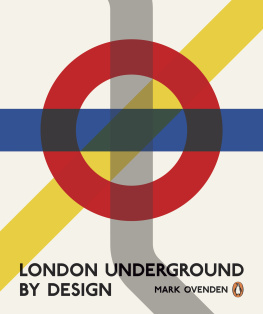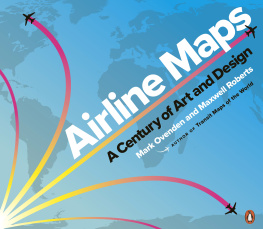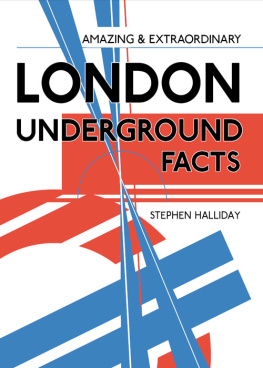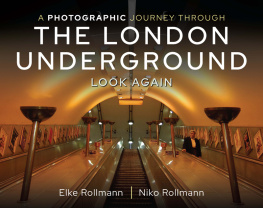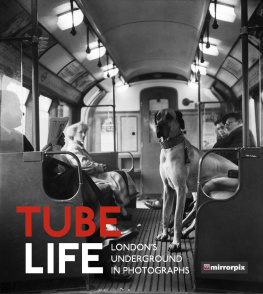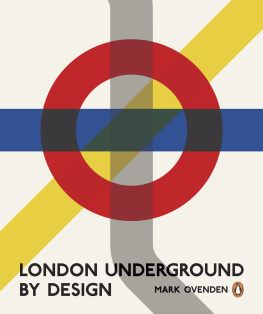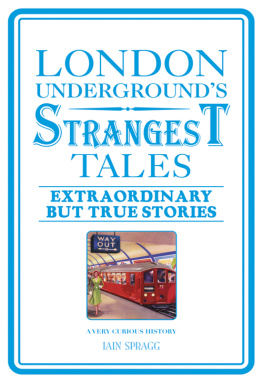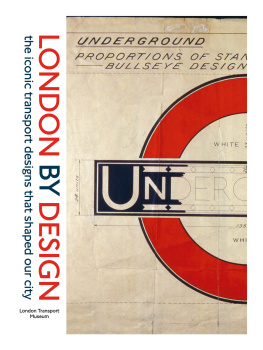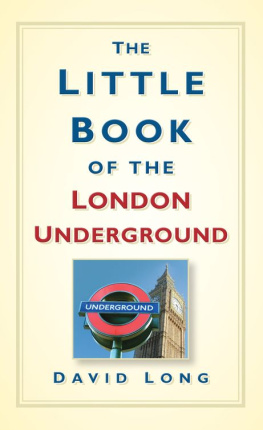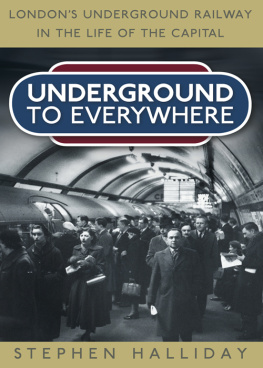Mark Ovenden
LONDON
UNDERGROUND
BY
DESIGN

For Pat and Derek who picked Penguins for Tube travel
Picture Credits
The majority of the images in this book have been sourced from and reproduced with kind permission of the London Transport Museum, TfL Archives and the extensive private collections of those such as Mike Ashworth, Peter Lloyd, Derek Mayes and Max Roberts, plus many images from the authors own collection.
Additional images have been provided by courtesy of and with much appreciation to: Acanthus LW Architects ().
Images lent by various collectors above including from periodicals: Electric Review (), The copyright of all of the images remains with the original owners.
Introduction

Kevin McCloud, Channel 4s Grand Designs presenter and architect
To travel the underground is to travel through design time. One hundred and fifty years of it. From the crystalline concrete light wells of Heathrow Terminal 5 you can trundle six stops to the Art Deco triumphalism of Osterley, thence straight on to visit the glorious Arts and Crafts facade of Russell Square before changing at Kings Cross to admire the original Victorian brickwork of the Metropolitan line, the first underground railway in the world, completed in 1863. This will lead you to the planetarium for a forty-five minute tour of Deep Time. Nothing, however, rivals the architectural and design experience of the Underground. It is encapsulating and immersive; a contrived world that you cannot confuse with a National Trust tour, thanks to the advertising, the smell of brakes and the purposefulness of it all. The Underground is no heritage site or fusty working museum. It is a complex, functioning piece of infrastructure, animated by the one billion people that use it every year, as much as by the trains.
Travelling within the confines of the Circle line, it would be tempting to think of the Underground as a principally twentieth-century invention. It was not. It was a twentieth-century reinvention or integration of a system that had grown with lightning speed between 1863 and the end of the nineteenth century, created by rival operating companies of different lines: the Met, the District, the City and South London Railway, the Central London Railway or Tube and the Underground Electric Railway Company of London. Their separate identities are still clearly visible on the suburban lines. Was there a coherent style? No. There was a jumbled mass of architecture, typefaces and liveries, especially in those early years of steam. Simple wooden stations vied with ornate brickwork and the lunatic Ottoman extravagance and thirty-metre minarets of Blackfriars Underground station. Timetables and maps were printed with gothic tracery and vignettes of the corners of the Empire. Amidst all this mayhem, however, there were the inklings of clarity. For example, the original Metropolitan Railway had, almost from the start, adopted clear, sans-serif typography for its signage, redolent of the mainline railways, and a relatively consistent architectural language in the popular Italianate style.
With the passing of the decades and with electrification of the Underground came greater coherence. With electric lighting came white glazed tiling that was to influence the style of Underground stations from Budapest to Paris (which lifted Londons emerging design ethos wholesale). And all the while, thanks to its decades-long head start, Londons Underground was haphazardly forging, from the scramble of the vying companies ambitions, a design code, architectural language and brand identity. Not that any of these terms or concepts existed as such.
The overwhelmingly period and coherent feel of the Tube results in no small part from the co-ordinated work of Frank Pick, erstwhile publicity officer, commercial manager and finally managing director of the Underground Electric Railways Company of London. He steered its branding and identity out of the Edwardian period into the Modern age. Nikolaus Pevsner described him as the greatest patron of the arts whom this century has so far produced in England, and indeed the ideal patron of our age. Pick adopted the famous topological map, designed by engineering draughtsman Harry Beck in 1931 in his spare time (not commissioned and not received with a great deal of enthusiasm from London Underground); he commissioned the typeface designed by Edward Johnston to Picks brief in 1913 (surely it feels much later?); he coordinated signage and architecture across the entire network.
The Undergrounds latterday character has been as accretive and (almost) as clearly directed. It remains a glorious palimpsest of design, a repository of design work and design values of the last one hundred and fifty years, a sort of working reference that charts the history of taste and style. So this is not a book merely about the growth of Londons Tube network. It records the birth of a new idea in the nineteenth century the transport interchange and unfolds the invention of branding in the twentieth. It plots the organization of commercial illustration, lettering design and printing into a new discipline called graphic design. It follows the adaptation of architecture into a commercial tool. It also roundly celebrates the Titans of engineering and design, individuals like Benjamin Baker, who built a transport system so coherent, it paved the way for London to grow into the international city it now is.
Abbreviations
Bakerloo see
Board see
BPCR Brompton and Piccadilly Circus Railway
BSWR/Bakerloo Baker Street and Waterloo Railway
CCEHR/Hampstead Charing Cross, Euston and Hampstead Railway
CLR Central London Railway
CMP Compagnie du Chemin de Fer Mtropolitain de Paris
CSLR City and South London Railway
DIA Design and Industries Association
District Metropolitan District Railway
DLR Docklands Light Railway
DRU Design Research Unit
ELL East London line
ELR East London Railway
GER Great Eastern Railway
GLC Greater London Council
GNCR Great Northern and City Railway
GNPBR/Piccadilly Great Northern, Piccadilly and Brompton Railway
GNR Great Northern Railway
GWR Great Western Railway
Hampstead see
HCR Hammersmith and City Railway
HLS Henrion Ludlow Schmidt
JLE Jubilee Line Extension
LBSC London Brighton and South Coast
LDDC London Docklands Development Corporation
LMS London, Midland and Scottish Railway
LNER London and North Eastern Railway
LNWR London and North Western Railway
LPTB/Board London Passenger Transport Board
LSWR London and South Western Railway
LT London Transport
LTSR London Tilbury and Southend Railway
LU London Underground
LUL London Underground Limited
Met Metropolitan Railway
NER North Eastern Railway
NWP New Works Programme
PEDs platform-edge doors
PFA Platform for Art
Piccadilly see
PPP PublicPrivate Partnership
RIBA Royal Institute of British Architects
SECR South Eastern and Chatham Railway
TfL Transport for London
UERL Underground Electric Railways of London
WLR West London Railway
Acknowledgements
A book such as this is rarely just the work of one individual but inevitably it is assembled by an author against the backdrop of many loving and supportive hands. The initial inspiration for this project came during discussions with Mike Ashworth, David Ellis, David Lawrence, Christopher Saynor and Mike Walton who have provided encouragement to the author on several published works. He is indebted to Helen Conford for seeing the possibilities of the book and running with it, the artistic guidance of Jim Stoddart, and the help of Rebecca Lee, Patrick Loughran, Richard Marston, Hannah Bradbury and the publicity department at Penguin.

